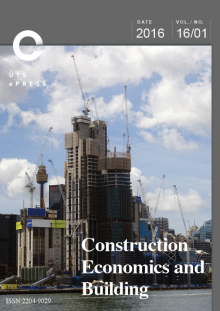A comparative study of floor construction on sloping sites: an analysis of cumulative energy demand and greenhouse gas emissions
Main Article Content
Abstract
In order to make environmentally aware decisions, there is growing interest in the comparative energy and greenhouse gas (GHG) performance of competing construction methods. Little research has been done concerning competing ground floor construction methods, especially given different site variables, such as slope and soil type. A life cycle assessment approach was adopted to analyse environmental impacts, including cumulative energy demand and GHG emissions for detached housing construction in Australia. Data was drawn from 24 case study housing projects, including 12 reinforced concrete and 12 suspended timber floor projects. The data presented in the paper compares cumulative energy demand, GHG and the constituent parts of competing construction methods. The findings indicate that the timber floors use/create significantly less cumulative energy demand and GHG emissions than concrete floors—approximately 2.1 to 2.7 times less energy and 2.3 to 2.9 times less GHG. These findings are limited to the site slope and foundation soil types identified in the paper. The main application of the work is in guidance concerning the lowest environmental impact options for detached housing construction.
Article Details
Section
Authors who publish with this journal agree to the following terms:
a) Authors retain copyright and grant the journal right of first publication with the work simultaneously licensed under a Creative Commons Attribution License that allows others to share and adapt the work with an acknowledgement of the work's authorship and initial publication in this journal.
b) Authors are able to enter into separate, additional contractual arrangements for the non-exclusive distribution of the journal's published version of the work (e.g., post it to an institutional repository or publish it in a book), with an acknowledgement of its initial publication in this journal.
c) Authors are permitted and encouraged to post their work online (e.g., in institutional repositories or on their website) prior to and during the submission process, as it can lead to productive exchanges, as well as earlier and greater citation of published work (See The Open Access Citation Advantage Service). Where authors include such a work in an institutional repository or on their website (ie. a copy of a work which has been published in a UTS ePRESS journal, or a pre-print or post-print version of that work), we request that they include a statement that acknowledges the UTS ePRESS publication including the name of the journal, the volume number and a web-link to the journal item.
d) Authors should be aware that the Creative Commons Attribution (CC-BY) License permits readers to share (copy and redistribute the work in any medium or format) and adapt (remix, transform, and build upon the work) for any purpose, even commercially, provided they also give appropriate credit to the work, provide a link to the license, and indicate if changes were made. They may do these things in any reasonable manner, but not in any way that suggests you or your publisher endorses their use.
